For a few words about my
reviewing process and preferences, please see the introduction to
Classical Reviews # 36.

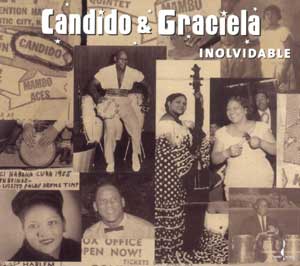 |
CANDIDO & GRACIELA: INOLVIDABLE •
CHESKY JD249
|
|
0 |
5 |
|
Performance |
 |
|
Sonics |
 |
|
Three cheers for David Chesky. Somehow he has managed to lure two of Cuba's
great music legends out of retirement to make a state-of-the-art recording.
Listening to this music is like taking a trip back in time, to the era of
Ricky Ricardo, Miami nightclubs, and the popular music of an era in which
Cuba was not cast as the enemy of the American people.
For well over 40 years, Graciela (Perez) was known as the First Lady of
Afrio-Cuban Jazz. Originally the lead vocalist for Machito and his
Afro-Cuban Jazz Orchestra, she began the partnership in the early 1940s and
continued singing with the orchestra through the ‘70s. After parting ways
with her older brother Machito, she joined her brother-in-law Mario Bauza's
band. She continued performing until 1993, when Bauza's death signaled her
time to step back.
Happily, a request from 82-year-old conguero Candido Camero to join her on
an album of familiar old tunes lured the Havana-born Graziela out of
retirement. Even at 88, and crippled by arthritis, the woman is a wonder.
Graziela, who has known Candido for over 60 years, is quoted on the album
notes as saying, “I only agreed to do it because Candido was going to be
involved. People are always asking me to sing for them, but I have known him
for so many years that recording with him was not a big deal.”
The disc, recorded in state-of-the-art sound in the Manhattan Church that
Chesky regularly converts into a recording studio, is marvelous. Graziela
sings on seven tracks, variously joined by Candido on triple-congas plus
plus a band of expert Latin jazz artists consisting of violin, flute, piano,
bass, percussion, back-up singers, and special guest vocalist Xiomara
Laugart. Although there is nothing like Graziela's voice, the pure
instrumental selections are equally inolvidable (unforgettable).
The amazing thing is how good Graciela sounds. The voice sounds less
weathered than mature, possessing an earthiness singers 1/4 her age would
figuratively kill for. I don't know if the range is lower than in her
heyday, but all the notes are there, voiced with equal power. Energizing the
sound is a seemingly indomitable spirit that bespeaks the Cubop movement of
the late ‘40s.
Most extraordinary is how Graziela is still able to soften her voice on the
more romantic numbers, rounding off phrases with consummate skill. This is
not another case of a worn out singer croaking away for the sake of
posterity. Rather, it's the real thing, performed with a vitality and
presence that create musicianship of the highest order.
This disc is also fabulous for dancing. Imagine yourself on a ballroom
floor, a rotating globe of mirrors suspended above you swirling stars of
light on and you around as the music draws you deeper into the spirit.

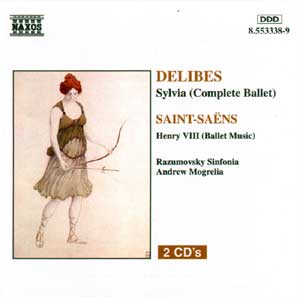 |
| SAINT-SAËNS: JAVOTTE (COMPLETE
BALLET) PARYSATIS (BALLET: INTRODUCTION AND THREE SCENES)
THE QUEENSLAND ORCHESTRA, ANDREW MOGRELIA
MARCO POLO 8.223612
|
|
0 |
5 |
|
Performance |
 |
|
Sonics |
 |
|
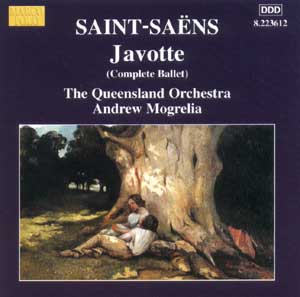 |
| SAINT-SAËNS: MUSIC FROM HENRY VIII
DELIBES: GISELLE (COMPLETE BALLET)
RASUMOVSKY SINFONIA, ANDREW MOGRELIA
NAXOS 8.553338.
|
|
0 |
5 |
|
Performance |
 |
|
Sonics |
 |
|
Andrew Mogrelia, the relatively new Music Director of the San Francisco
Ballet, has recently released recordings of two infrequently performed
ballet scores by Camille Saint-Saëns (1835-1921), one of the great French
composers of the last two centuries, Though the ensembles, the Queensland
Orchestra and the Razumovsky Sinfonia, reside many light years from San
Francisco and France, the quality of the conducting supplies ample evidence
of Mogrelia's expertise in this arena.
If you find ballets populated by rustic villagers, courting couples, and
pleas for a daughter's hand forbiddingly old-fashioned, the complete score
to Saint-Saëns' 1909 Javotte will not get your mojo working. The
tradition-bound tale inspired Saint-Saëns to compose thirty-one short
sections totaling an hour in length. The musical results may be decidedly
square, but they are also superbly crafted. That the composer manages to
create a seamless score, as free flowing as the best from Frankl, Hermann,
and Williams is much to his credit.
Every note of Javotte has ballet written all over it. You know what the
dancers are going to do as soon as you hear the music. If that makes
Saint-Saëns' score sound as predictable as the yawn-inducing plot, it does
not detract from its urbane albeit unquestionably tame charm. The Finale to
Scene 2 is very Mark Morris; what that choreographer could do with
Saint-Saëns' setting of the parents' discovery that their daughter is
missing would leave an audience in stitches. Though the composer may have
dispensed such music with an air of self-satisfied smugness, one can only
admire his administrative skills.
Javotte is paired with the Introduction and three scenes from Saint-Saëns'
incidental music to the play Parysatis. This music, far more Egyptian and
pseudo-Oriental in tone than Javotte's, sounds like Scheherazade in less
expensive shoes. Perhaps Saint-Saëns was drawn to the play because its
author Jane Dieulafoy dressed as a man. At the 1902 premiere in the Arena at
Béziers, she appeared onstage in male drag with Saint-Saëns at her side to
acknowledge the audience's considerable applause.
These Marco Polo performances, distributed by Naxos, find Mogrelia and the
Australian Queenslands in fine form. Every forte, every accent, every
sweetly scented note you could wish for is here. The Moderato from Parysitis
is especially noteworthy for its graceful arches of sound. Mogrelia's every
bar beats ballet.
A Naxos two-discer mainly devoted to a fine, competitive recording of Léo
Delibes' classic ballet Sylvia serves up dessert via 20 minutes of
Saint-Saëns' Ballet-Divertissement from Act II of his forgotten opera Henry
VIII. S-S wrote the work in 1883, two years after separation from his young
wife. Here you will find a grand English processional - my listening
companion found it more tutti-frutti than British - other assorted quasi-anglicisms,
and a lovely “fete du Houblon” that has classical FM radio's watered down
pale-faced pleasantries written all over it.

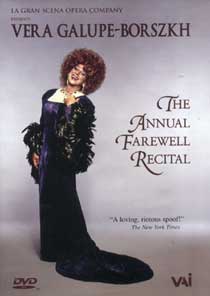 |
VERA GALUPE-BORSZKH: THE ANNUAL
FAREWELL RECITAL • MAESTRO SERGIO ZAWA, PIANO • VAI DVD 4250
|
|
0 |
5 |
|
Performance |
 |
|
Sonics |
 |
|
The stultified conventions, absurd plots, romantic and dramatic excesses,
overblown stagings, and behind-the-scenes personal intrigue of opera,
ballet, and classical music have long provided fertile ground for parody. In
the last century, humorist Victor Borge and soprano cum baritone Anna
Russell built their careers on variously satirizing classical music and the
operas of Wagner. More recently, Les Ballets Trockadero and La Gran Scena
Opera Company have built international touring careers based on all-male
travesty adaptations of their respective classical mediums.
Ira Siff, currently a major critic for Opera News who coaches voice students
internationally and directs opera performances, co-founded La Gran Scena
Opera Company in New York City in 1981. As you will read in the extensive
interview to be published here in August, 2004, Siff had no idea that the
highly respected New York Times critic Bernard Holland would show up on
opening night. Holland's subsequent review, which appeared in the Times,
instantly garnered the company a loyal following.
Over the years, the company staged regular performances in New York and
abroad, garnering international acclaim. The company grew in size from two
to twelve or thirteen. I recall seeing them in their glory days in New York
City, reveling not only in Siff's artistry but also in the charm with which
America's most beloved retired diva, Sylvia Bills, introduced the
selections.
In 1986, Siff, whose alternate persona was the Croatian singing actress Vera
Galupe-Borszkh, began spoofing the tradition of soprano farewell recitals by
staging such events on an annual basis. Originally intended for a small
audience, these too took off, garnering an increasingly larger following.
Madame Galupe-Borszkh eventually staged excerpts from her recitals for opera
galas in Carnegie Hall, Avery Fisher and Alice Tully Hall, London's
Bloomsbury Theater, The Covent Garden Festival, and countless other venues
and festivals. These spoofs drew such opera notables as Dame Joan Sutherland
and Richard Bonynge, Leontyne Price, James Levine, Renata Scotto, Aprile
Millo, Sherrill Milnes, Anna Moffo, and Martina Arroyo.
Critical reaction was universally positive. The New York Times called the
performances “A loving, riotous spoof!” and Time exclaimed “Stupendous
singing! Magnificent excess!”
The genius of Siff's Diva alter ego is now available to enjoy for anyone
with a DVD player . The main part of this 243-minute program consists of a
live recital, taped on April 30, 2003 at La Belle Epoque in New York City.
Vera had by this time reached the end of her illustrious career. What the
voice could no longer accomplish with the same agility and tonal sheen as in
days past is more than compensated for by a sophistication of shtick and
presentation.
Madame Galupe-Borszkh sings everything from material suited to her voice,
nationality, and temperament, such as Poulenc's truly beautiful “Les Chemins
de l'amour,” to such inappropriate repertoire as a Mandarin folksong
entitled “The Horse,” Gershwin's “S'wonderful” (performed with a pseudo
Croatian accent and irrepressible urge to scat sing), and the traditional
African-American spiritual, “Ride on Jesus” (which left Leontyne Price in
stitches). In between we get such classics as Ponchielli's “Suicidio!” from
La Gioconda, Boito's “L'altra notte in fondo al mare” from Mefistofele, and
Schubert's “Erlkönig” (with the Diva of course taking full advantage of the
song's opportunities to create three different characters and voices within
a span of a few minutes).
The so-called bonus material is actually essential for a full appreciation
of Vera's artistry. The final scene from Donizetti's Roberto Devereux and
Ophelia's Mad Scene from Thomas' Hamlet were no doubt beyond the Diva's
reach in 2003, but easily accomplished and thereby destroyed earlier on. The
shtick is a little less sophisticated, the gestures not as perfectly worked
out, but the voice is in better shape. Here the able accompanist is Maestro
Francesco Folinari-Soave-Coglioni, who is rumored to have shined shoes in
Penn Station in his spare time. The self-same Maestro also accompanies “The
Essential Vera,” which includes performances of works by Straus, Poulenc and
Cilèa.
No DVD worth its salt would be issued without behind the scenes interviews.
Thus we are treated to two tracks of “Ira Siff: The Man Behind the Diva.”
Siff is a comic genius, and the interviews discussing both Vera and La Gran
Scena Opera Company are not to be missed. Neither is the rest of this
treasurable DVD. By all means . . . .

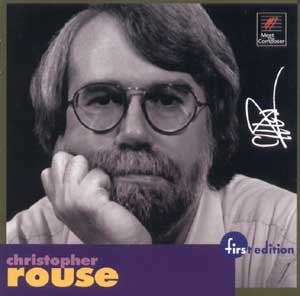 |
| CHRISTOPHER ROUSE BALTIMORE
SYMPHONY ORCHESTRA, DAVID ZINMAN
FIST EDITION MUSIC FECD-0026
|
|
0 |
5 |
|
Performance |
 |
|
Sonics |
 |
|
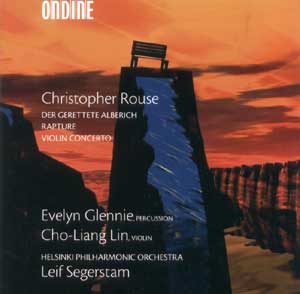 |
| CHRISTOPHER ROUSE: DER GERETTE
ALBERICH, RAPTURE, VIOLIN CONCERTO EVELYN GLENNIE, PERCUSSION
CHO-LIANG LIN, VIOLIN
HELSINKI PHILHARMONIC ORCHESTRA, LEIF SEGERSTAM
ONDINE ODE 1016-2
|
|
0 |
5 |
|
Performance |
 |
|
Sonics |
 |
|
Christopher Rouse has become one of America's most-performed orchestral
composers. Born in Baltimore in 1949, Rouse's studies with composers George
Crumb and Karel Husa helped develop skills that eventually won him the 1993
Pulitzer Prize in Music for his Trombone Concerto (1990-1991).
A succession of concerti for various instruments followed. These included
the Violin Concerto (1991) written for violinist Cho-Liang Lin, and the
Guitar Concerto (1999), whose recording by Sharon Isbin won Rouse a Grammy
in 2002 for “Best Contemporary Composition.” Thanks to his long association
with conductor Marin Alsop, Rouse's works are regularly performed at Santa
Cruz's Cabrillo Music Festival of Contemporary Music.
Rouse's compositional style has gone through successive stages. Works from
the 1980s and early ‘90s shared a melancholic preoccupation with darkness,
death, grief, and despair. Subsequent pieces at first suggested that Rouse
might have passed through the gloom and become more occupied by the light.
Not quite. At Cabrillo's 2001 West Coast premiere of his Rapture (2000),
Rouse confessed “man can not live by dread alone.” Acknowledging that the
previous five years had found him “looking more to the light than to the
abyss,” he stated that Rapture would be his “valedictory” exploration of
light as he allowed himself to move in “other” directions.
To say that percussion plays a major part in Rouse's compositions is an
understatement. The man seems to thrive on the big bang. Even Rouse's Violin
Concerto is as dominated by percussion as by the sounds of the violin.
The First Edition disc is a remastering of two late ‘80s recordings by the
Baltimore Symphony Orchestra, of which Rouse was composer-in-residence from
1986 through 1988. Both pieces were originally issued in 1989 on a single
Nonesuch CD.
Great care has been taken to reissue these Judith Sherman-produced
performances in the best possible sound. Liner note acknowledgements to Joe
Fratus of Art Audio, Kevin Halverson of Muse Electronics, Ray Kimber of
Kimber Kable, and Pierre Sprey of Mapleshade Records suggest a true
audiophile collaborative effort.
Symphony No. 1 (1986) signaled Rouse's intention to return to a time-honored
compositional form that had been rejected by the radical serialists of the
20th century. The entire symphony was inspired by and built around a piece
of music Rouse composed in 1976 while still a student. The symphony depicts
a besieged and attacked hero “who is utterly destroyed, but whose
destruction brings no such ennoblement to mankind.” Rouse likens it to death
without transfiguration.
The 27-minute score consists of a slow, somber single-movement adagio.
Dedicated to composer John Harbison, there is a direct reference to the
opening theme of the adagio from Bruckner's Seventh Symphony (here performed
by a quartet of Wagner tubas). Rouse also employs the D-S-C-H (D-E flat-C-B)
motive that Shostakovich used in some of his scores to signify his initials.
Though the work that became the central part of the symphony was initially
composed in response to a dream, the composer here associates it with the
Pieta.
Phantasmata (1981/1985), the other work on the 46-minute CD, consists of
three separately composed parts. With the title derived from physician and
occultist Paracelsus' use of the term phantasmata to refer to
“hallucinations created by thought,” the work is hardly a bowl of cherries.
The first part, The Evestrum of Juan de la Cruz in the Sagrada Familia at 3
A.M., uses the Paracelsian term “evestrum” to refer to the astral body that
extends out from the physical body. Scored for strings and percussion, the
movement represents “a dreamt out-of-body somnambulatory journey through
Antoni Gaudi's Cathedral of the Sagrada Familia in Barcelona.” The feeling
is one of suspended, barely perceptible movement.
The second part, The Infernal Machine for full orchestra, presents a darker
hallucinatory image of a sinister, self-sufficient machine eternally in
motion for no particular purpose. Finally, Bump is a menacing, nightmarish
offbeat conga which the wicked Rouse fantasized as a kind of Boston Pops
performance in hell.
The Ondine 24-bit recording features more recent works. It begins with a
definitive performance of Der Gerettete Alberich (1997), Rouse's Fantasy for
Solo Percussion and Orchestra dedicated to the disc's astounding
percussionist Evelyn Glennie. Opening with a theme from Wagner's Die
Götterdämmerung, the work explores the possibility that the distasteful
dwarf Alberich continues to exist after Wagner's Ring Cycle ends. Beautiful,
emotion laden Wagnerian motifs emerge, only to find themselves tossed,
turned, and pulverized by outrageous amounts of heavy metal percussion. In
the course of the work, Alberich moves from sympathetic reflection on his
tragic life to launching a rampage with the goal of world domination. Rouse
is being more than a bit wicked here, slyly winking at us through the din.
It's a trip.
I first heard Rouse's ecstatic Rapture (2000) at the 2001 Cabrillo Music
Festival. Performed in Mission San Juan Bautista, the effect was incredible.
Members of the audience, especially those closer up, were literally washed
over and submerged by wave upon wave of joyful, light-filled music. It's
hardly the same experience listening to a recording, but that doesn't lessen
the beauty of this barely 13-minute work.
Rouse wrote the two-movement Violin Concerto (1991) for soloist Cho-Liang
Lin. The work begins on an eerie note, with a gorgeous interplay between
solo violin and strings. At times the music becomes demonic, like a dance of
death. As with all of Rouse's work, despite the morbidity and percussion
that could rouse, there is a depth of feeling that makes the concerto quite
compelling.

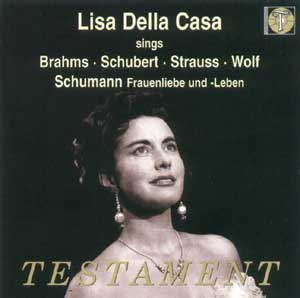 |
| LISA DELLA CASA SINGS BRACHMS •
SCHUBERT STRAUSS • WOLF • SCHUMANN
TESTAMENT SBT 1341
|
|
0 |
5 |
|
Performance |
 |
|
Sonics |
 |
|
Born in 1919, Swiss soprano Lisa Della Casa began performing on major
stages in her early 20s. Starting in 1943, Zurich saw her in a succession of
such roles as Gershwin's Serena (Porgy and Bess), Mozart's Pamina and Queen
of the Night (Magic Flute), Verdi's Gilda (Rigoletto), Puccini's Mimi (La
Bohéme), and Sophie (Der Rosenkavalier). Thanks to soprano Maria Cebotari,
she assumed the role of Zdenka for the 1947 Salzburg revival of Richard
Strauss' Arabella. Her association with Strauss roles continued at the
Vienna State Opera, where she sang Octavian, Arabella, the Countess in
Capriccio, and eventually the Marschallin, Salome and Chrysothemis. Hers
also became the first commercial recording of Strauss' Four Last Songs,
recorded at age 34.
Mozart roles were also a staple for this light, silvery soprano. The
Countess was the role of her 1951 début at Glyndebourne and 1953 Met début.
She remained at the Met until 1968, giving up the stage entirely in 1973.
If I dwell so much on Della Casa's opera career, it is because she rarely
gave performances of German lieder. Leaving that field to Irmgaard Siefried
and Elisabeth Schwarzkopf, the two most respected soprano exponents of the
genre in the ‘50s and early ‘60s, she instead focused on operatic roles.
Della Casa's excellent as a song recitalist was first brought to my
attention by a late ‘90s issue of a live recital given in Salzburg in 1957
(EMI Classics 723 5 66571 2 0). I marveled at the delicacy of her artistry,
the silver shimmer of her unique timbre, and the subtlety of her expression.
Those feelings are only reinforced by this marvelous Testament issue of
studio performances of Brahms, Schubert, Strauss, and Wolf lieder recorded
in mono in 1956 (with Karl Hudez at the piano) and the eight songs of
Schumann's Frauenliebe und Leben, Op. 42, recorded in stereo in1962 (with
Sebastian Peschko). Sticking to well-known songs by these composers, the
1956 recordings find Della Casa in ideal voice. Lieder such as Brahms' “Von
ewiger Liebe” and Schubert's “Gretchen am Spinnrade” are usually performed
by singers with weightier voices. What a pleasure, then, to discover the new
dimensions they take on when performed with such lightness and grace. You
don't have to be a vocal heavyweight to have these feelings, Della Casa
seems to say. The beauty of her interpretations proves her correct.
Two of the four Brahms songs, three of the four Schubert, and three of the
four Strauss were also recorded live in Salzburg. There are myriad
differences in accents and emphasis. Della Casa was clearly quite
comfortable in front of the microphone; the live performances are not
necessarily better, just different. In fact, to these ears the often
understated studio recordings frequently strike a deeper chord.
Special attention must be paid to Strauss' “Befreit,” a six-minute song so
beautifully developed and felt that it immediately defines what is special
about Della Casa's artistry. Certainly there are sopranos who swell more on
the climax, but the economy of Della Casa's expression allows the music to
speak in the strongest possible terms.
The Frauenliebe und Leben shows the soprano in a less exuberant, more inward
state. Perhaps benefiting from the passage into her early 40s, Della Casa's
tone takes on a newfound profundity that transforms Schumann's cycle into a
deeply personal confessional. Listeners who share my belief that these songs
reinforce male stereotypes of how women are supposed to feel are encouraged
to listen to this remarkable version. Della Casa, at times sounding urgent,
sings as if every feeling were hers and hers alone.

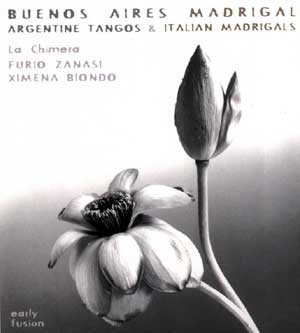 |
BUENOS AIRES MADRIGAL • LA CHIMERA •
FURIO ZANASI * XIMENA BIONDO • M.A RECORDINGS MO63A
|
|
0 |
5 |
|
Performance |
 |
|
Sonics |
 |
|
With new distribution by Classiquest and Trade Secrets, Todd Garfinkle of
M.A Recordings has released yet another of his extraordinary multi-cultural
explorations. This time he mixes Argentine Tangos and 17th century Italian
madrigals. The ostensible purpose of this curious mix is to “journey through
the fundamental subject area that inspired both the old Italian Madrigal and
the Buenos Aires Tango… Through migrations, solitude, conflicts, absence,
dance, dreams, and death. Through the ‘places of the soul' united and marked
by irreparable loses, voyages of no return, hopes on the other shore,
exercises in nostalgia.”
Oh my. Truth be told, lots and lots of music takes us on similar journeys,
from early Appalachian folk music to rock ballads. I question just how much
is revealed by the unusual juxtaposition of music from an earlier Italy and
modern Argentina. But accepted on its own terms, as music per se, there is
much here to enjoy.
Singers Furio Zanasi and Ximena Biondo y have the drama of Argentinean tango
in their voices and blood. The longing and heart-throbbing emotion of
Piazzolla, Gardel and other composers is milked for all it's worth; nothing
is left to the imagination. What's most interesting is the extent to which
the singers adopt similar modes of expression when performing tango and
classic madrigals by Frescobaldi, Monteverdi, Cavalli, and de Rore.
Listening to Zanasi first sing Troilo's “Garüa” and followed by Monteverdi's
(attrib.) “Voglio di vita uscir” leaves me wondering which was is up.
Credit must go to the accompaniment by La Chimera, an excellent ensemble
that mixes Argentinean bandoneón, harmonica, and guitar with violins, viola
da gamba, baroque cello, double bass, and lutes. Their instrumental solos
are quite beautiful, if not always authentic sounding. Definitely a disc
worth exploring, with M.A's spacious, demonstration-quality sonics a
definite plus.
- Jason Victor Serinus
-